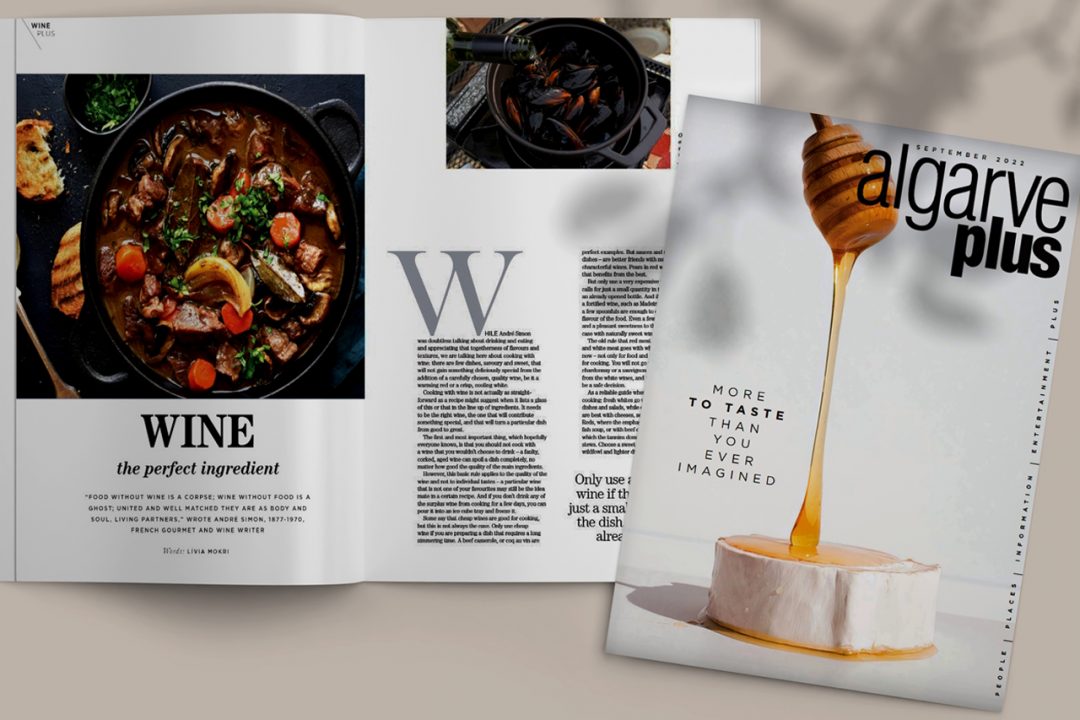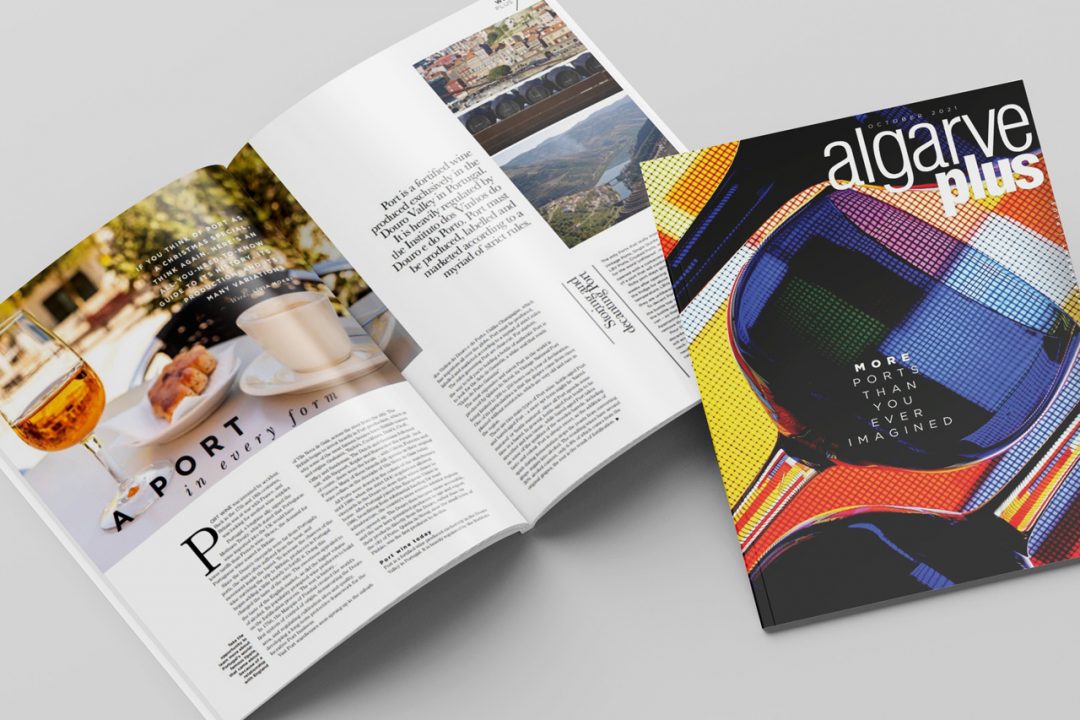Wine – the perfect ingredient! “A meal without wine is like a day without sun!”
“Food without wine is dead; wine without food is only a ghost; but if we combine and pair them well, they become living partners, like body and soul,” wrote André Simon, French gourmet and wine writer.
Do you know what wine to add to the food when the recipe says “pour with wine”? In my latest article, I teach you what wines to use when cooking.
I am happy to share that my new article in the Algarve Plus Magazine has been already published!
The magazine is readable online or downloaded for free here.
Enjoy!
Or read here the whole article:
Wine – the perfect ingredient
„Food without wine is a corpse; wine without food is a ghost; united and well matched they are as body and soul, living partners.”
– wrote André Simon, French-born gourmet and wine writer
Whether it is worth cooking with wine should not even be a question! We can say that today we can sneak a few sips of wine into almost any recipe. Cooking using wine has always been wonderful. Sauces, risottos, roasts, stews, syrups, jams, and jellies… it doesn’t matter. Sweet or savory, your dish will gain special flavor with the addition of the noblest wines.
Okay, maybe it doesn’t go with a classic vegetable stew, but when it comes to cooking, it goes with almost everything – there are just some types of food that almost cry out for it, while others hide it as a delicious little secret ingredient. But how should we choose if we want to cook with wine?
Cooking well with wine is not as easy as the recipes suggest. On the other hand, you can use wine for cooking not only when the recipes recommend it.
Here are my tips, which if you take to heart, the wine will definitely enhance the shine of your dish.
The first and most important thing, which hopefully everyone knows, is that we should not put that wine into the food that we wouldn’t drink either! A faulty, corked, aged wine can spoil the whole meal. However, the above rule only applies to the quality of the wine and not to our taste – just because a wine variety is not one of our favorites does not mean that it does not go well with the food. It may happen that the recipe calls for a wine that is less to your taste anyway. But no need to be scared! Since a lot of other ingredients go into the food as well, you won’t feel it too much, but this will make the end result harmonious.
And if we know that we will not drink the wine used for cooking within a few days, we can, for example, pour it into an ice cube tray and freeze it.
There is a saying that cheap wines are good for cooking, but this is not true. We should only cook with cheap wine if we are preparing a meal that has been simmering for a long time. A beef stew or similar dish that takes a long time to prepare – and you are not, for example, suddenly frying a fish in the pan, then wine with a better value for money is also perfectly suitable. But sauces are better friends with more expensive, characterful wines, for example. The end result will be fantastic.
But it doesn’t have to be the most expensive wine at all. Only use a very expensive one if you need just a little of it in the dish, and you already have an opened bottle. It’s a shame to open a new bottle just for cooking.
And if we are dealing with fortified wine, such as Madeira or Fino sherry, then a few spoonfuls are enough to deepen the flavor of the food. Even a few drops can add strength and a pleasant sweetness to the dish. The same is the case with natural sweet wines, such as Tokaji Aszú.
The old rule that red meat goes with red wine and white meat goes with white wine, is now out of date – and this is not only true for food and wine pairing, but also for cooking. If we’re groping around blindly, we never choose wrongly if we try a dry, fresh chardonnay or a sauvignon blanc with light character from the white wines. In the red wine line, the more neutral merlot can be a safe decision.
If you are unsure, a few basic things can provide you with a reliable guide when choosing a wine for cooking: fresh white wines go well with poultry, citrus dishes, and salads, while deeper, wooden-barrel whites go well with cheeses, seafood, and spicy Asian dishes. From red, where the emphasis is on acid, it can be used in fish soup, or with beef, pork, and in which wines the tannins dominate, go well with venison and stews. Sweet for desserts, rosé for wildfowl and lighter dishes made with pork.
How to use wine in preparation?
Typically, wine is used in three stages in the preparation of food. The first is the marinade, in which the food (meat, in general) is seasoned. Marinating in wine softens the texture of the meat and it will cook through faster. In addition, if you leave it in the marinade for long enough, a new taste reminiscent of game meat is created.
The second moment is when the wine goes straight into the pot, as an ingredient. Here, a little patience is needed, as the alcohol must evaporate, as the food is not supposed to taste like alcohol. Therefore, you must wait the necessary time until the alcohol disappears, which will vary depending on the amount of alcohol used.
Also, pay attention to the amount of wine: never use wine by itself! In most recipes, a few milliliters of wine are enough to achieve a pleasant aftertaste. Don’t overdo it, otherwise, the wine will cancel out the flavor of the other ingredients. If it will be not enough, it is possible to correct it at the end of the preparation. And if the recipe says to add a large amount of wine, and the wine itself forms the basis of the sauce, for example, always add some other liquid. Depending on the recipe, this can be stock, cream, or concentrated tomatoes.
The third and final step is to use the wine as a reduction or sauce over low heat so that it is well-bodied and ideal to accompany fatty meats such as ribs.
And if you’re thinking of flambéing with wine, note that it’s not a good idea. This is a process best suited for drinks with high alcohol content, such as cognac, cachaça, and whiskey.
Which grape variety to choose for the recipe?
For those who want to delve even further into flavor combinations, it is not enough to pay attention to whether it is white, red or rosé and whether the wine is sweet, semi-sweet or dry. In this case, the ideal is also to pay attention to the type of grape. After all, each variety brings very different sensory characteristics. So it’s important to know what to expect from the combination.
But, among all the wine options, which one to choose for my recipe? This is a question that generates many doubts even in the most experienced cooks. Let’s see my suggestions according to the type of grape.
Among the white wines, the most suitable are Chardonnay (great to make your dish more full-bodied, as it adds denser texture to dishes), Sauvignon Blanc (great to use in preparations based on fish and seafood or vegetables due to its striking aromatic profile), and Pinot Grigio (more neutral being a wildcard for dishes that call for white wine).
In the case of reds, it is best to choose those that present more delicate tannins and are more fruity, without passing through the wood, to avoid the flavor being too strong and masking the other ingredients. Good examples are merlot, pinot noir and cabernet.
To harmonize the dish, remember to serve the same type of wine used in cooking.
But the most important rule is that everything that tastes good is allowed!
And always keep your mind on the famous saying that Jean Anthelme Brillat-Savarin, a French politician already said in the 18th century:
„A meal without wine is like a day without sun”.






No Comments Found